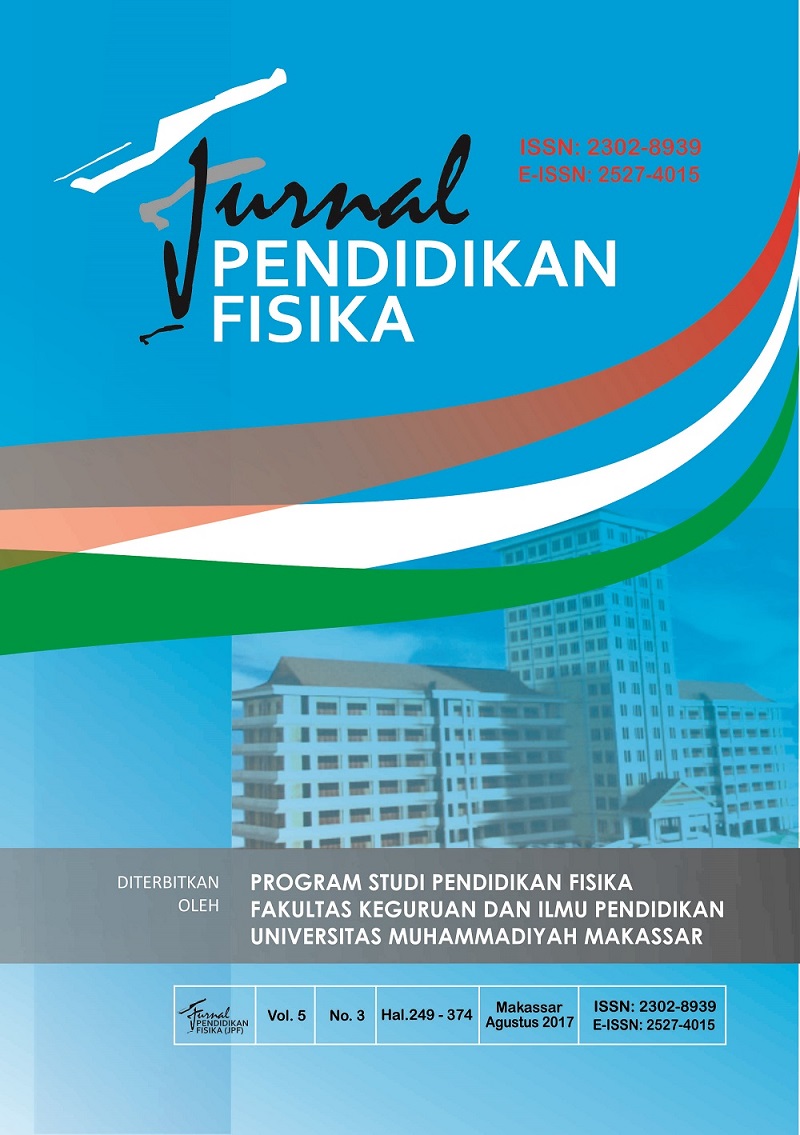Penerapan Strategi Prediction Guide Terhadap Hasil Belajar Fisika Pada Peserta Didik Kelas X MIA SMA Negeri 12 Makassar
DOI:
https://doi.org/10.26618/jpf.v5i3.853Abstrak
Jenis penelitian ini adalah Pra-Eksperimen yang dilaksanakan di SMA Negeri 12 Makassar, penelitian ini bertujuan untuk meningkatkan hasil belajar fisika melalui strategi pembelajaran Prediction Guide. Subjek penelitian ini adalah peserta didik kelas X MIA SMA Negeri 12 Makassar sebanyak 32 peserta didik yang terdiri dari 15 perempuan dan 17 laki-laki. Pengambilan data dilakukan dengan menggunakan tes awal dan tes akhir, lembar observasi, instrumen penelitian dibuat oleh penuis. Data yang dikumpul dianalisis dengan menggunakan teknik analisis statistik deskriptif. Hasil penelitian menunjukkan bahwa skor rata-rata peserta didik pada pretes sebesar 10,97% dan berada pada kategori rendah, dengan standar deviasi 2,87 sedangkan pada posttes diperoleh skor rata-rata sebesar 16,96% berada pada kategori tinggi dengan standar deviasi 2,55. Hal ini menunjukkan bahwa telah tercapai hasil belajar peserta didik berdasarkan Kriteria Ketuntasan Minimal (KKM) yang ditetapkan sekolah yaitu 70,00, di mana pada pretes dari 32 orang peserta didik terdapat 16 orang peserta didik atau 64% yang tuntas belajarnya dan terdapat 9 orang peserta didik atau 36% yang tidak tuntas belajarnya. Sedangkan pada posttes dari 25 peserta didik terdapat 19 orang atau 76% yang tuntas belajarnya dan terdapat 6 orang atau 24% yang tidak tuntas belajarnya. Dari hasil penelitian ini dapat disimpulkan bahwa dengan diterapkannya pembelajaran dengan strategi pembelajaran Prediction Guide pada peserta didik kelas X MIA SMA Negeri 12 Makassar maka hasil belajar Fisika dapat meningkat.
Kata kunci: Strategi Prediction Guide, Hasil Belajar Fisika
The research is a Pre-Experiments conducted at SMAN 12 Makassar, this study aims to improve learning outcomes through learning strategies physics Prediction Guide.The subjects were the students of class X of SMAN 12 Makassar MIA total of 32 learners consisting of 15 women and 17 men. Data collection was performed using the initial test and final test, observation sheets, research instruments made by penuis. The data collected were analyzed using descriptive statistical analysis techniques. The results showed that the average score of students in the pretest of 10.97% and is at a low category, with a standard deviation of 2.87, while the posttest obtained an average score of 16.96% at the high category with a standard deviation of 2 , 55. This shows that it has achieved learning outcomes of students based on a minimum completeness criteria (KKM) established in schools, 70.00, where the pretest of 32 learners there are 16 people or 64% of students who completed the study and there were 9 participants or 36% of students who did not complete her studies. While on the posttest than 25 learners there are 19 people or 76% of the completed study and there are 6 people or 24% who did not complete her studies. From these results it can be concluded that with the implementation of learning with learning strategies Prediction Guidelearnerson MIA X class SMAN 12 Makassar then physics can increase learning outcomes.
Keywords: Prediction Strategy Guide, Physical Learning Outco.
Referensi
Aunurrahman. 2009. Belajar dan Pembelajaran. Bandung : Alfabeta CV.
Zaini Hisyam, Munthe B, dkk. 2008. Strategi Pembelajaran Aktif. Yogyakarta : Pustaka Insan Madani.
Arikunto Suharsimi. 2006. Prosedur Penelitian Suatu Pendekatan Praktik. Jakarta: PT Rineka Cipta.
Ridwan. 2004. Belajar Mudah Penelitian Untuk Guru-Karyawan dan Peneliti Pemula. Bandung : Alfabeta.
Sudjana. 1992. Dasar-dasar Statistik. Yogyakarta : Pustaka Insan Madani.
Sugiono. 2009. Teknik Pengumpulan Data. Yogyakarta : Pustaka Insan Madani.
Winataputra, Udin, dkk. 1997. Strategi Belajar Mengajar. Jakarta : Universitas Terbuka.
Koes H,S. 2003. Strategi Pembelajaran Fisika. Malang : JICA
Unduhan
Diterbitkan
Terbitan
Bagian
Lisensi
Copyright:
Authors who publish with this journal agree to the following terms:
1. Authors retain copyright and grant the journal right of first publication with the work simultaneously licensed under a Creative Commons Attribution-ShareAlike 4.0 International License that allows others to share the work with an acknowledgement of the work's authorship and initial publication in this journal.
2. Authors are able to enter into separate, additional contractual arrangements for the non-exclusive distribution of the journal's published version of the work (e.g., post it to an institutional repository or publish it in a book), with an acknowledgement of its initial publication in this journal.
3. Authors are permitted and encouraged to post their work online (e.g., in institutional repositories or on their website) prior to and during the submission process, as it can lead to productive exchanges, as well as earlier and greater citation of published work.
Licence:
Authors are free to:
1. Share: Copy and redistribute the material in any medium or format
2. Adapt: Remix, transform, and build upon the material for any purpose, even commercially.
The licensor cannot revoke these freedoms as long as the authors follow the license terms, which include the following:
1. Attribution: You must give appropriate credit, provide a link to the license, and indicate if changes were made. You may do so in any reasonable manner, but not in any way that suggests the licensor endorses you or your use.
2. ShareAlike: If you remix, transform, or build upon the material, you must distribute your contributions under the same license as the original.
3. No additional restrictions: You may not apply legal terms or technological measures that legally restrict others from doing anything the license permits.
Jurnal Pendidikan Fisika is licensed under a Creative Commons Attribution-ShareAlike 4.0 International License.

